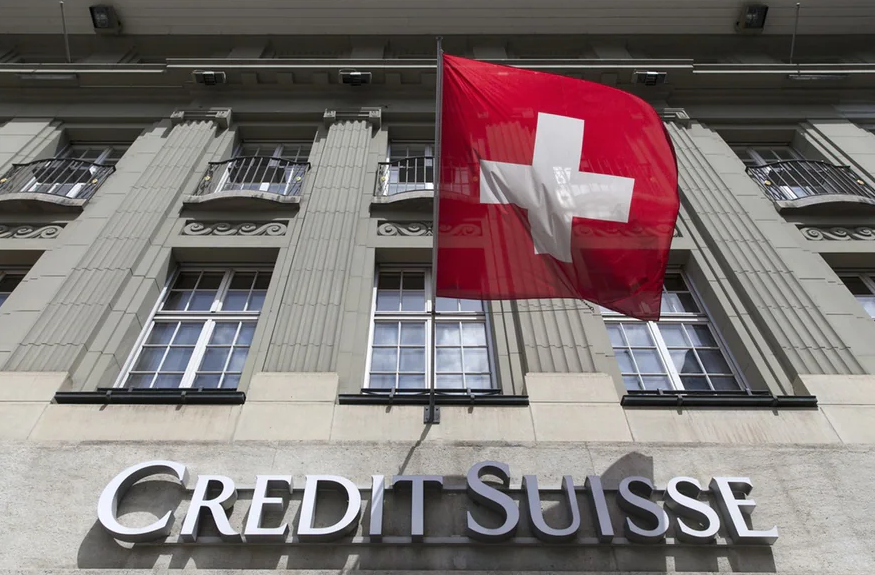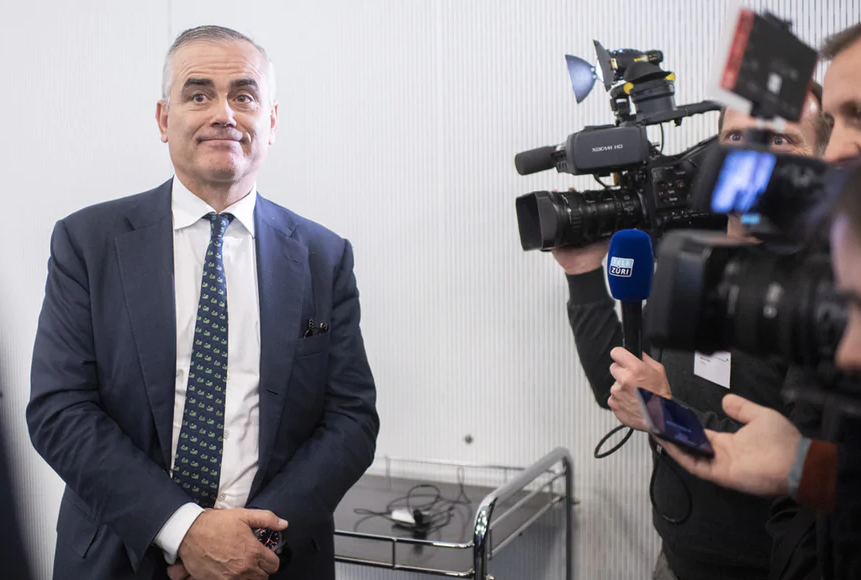Credit Suisse has recently been in the spotlight for all the wrong reasons Keystone / Peter Klaunzer As Credit Suisse executives finalised an emergency .9 billion (CHF1.75 billion) fundraising from investors last week, a group of the bank’s prized super-rich clients from across Europe and Asia were on a separate Zoom call hosted by law firm Boies Schiller Flexner to plot a class-action suit against the lender. The clients had been persuaded by Credit Suisse to invest in its collection of supply chain finance funds, backed by the now collapsed Greensill Capital, that were marketed as ultra-safe with “limited credit risk given multiple layers of protection”. Those on the call are among the 4,000 investors who ploughed a total of billion into the funds but who
Topics:
Swissinfo considers the following as important: 3.) Swissinfo Business and Economy, 3) Swiss Markets and News, Business, Featured, newsletter
This could be interesting, too:
Nachrichten Ticker - www.finanzen.ch writes Die Performance der Kryptowährungen in KW 9: Das hat sich bei Bitcoin, Ether & Co. getan
Nachrichten Ticker - www.finanzen.ch writes Wer verbirgt sich hinter der Ethereum-Technologie?
Martin Hartmann writes Eine Analyse nach den Lehren von Milton Friedman
Marc Chandler writes March 2025 Monthly

Credit Suisse has recently been in the spotlight for all the wrong reasons Keystone / Peter Klaunzer
As Credit Suisse executives finalised an emergency $1.9 billion (CHF1.75 billion) fundraising from investors last week, a group of the bank’s prized super-rich clients from across Europe and Asia were on a separate Zoom call hosted by law firm Boies Schiller Flexner to plot a class-action suit against the lender.
The clients had been persuaded by Credit Suisse to invest in its collection of supply chain finance funds, backed by the now collapsed Greensill Capital, that were marketed as ultra-safe with “limited credit risk given multiple layers of protection”.
Those on the call are among the 4,000 investors who ploughed a total of $10 billion into the funds but who now look set to lose up to a quarter of their stakes after Credit Suisse suspended the funds in March. Just weeks later, the bank was pummelled by its biggest quarterly trading loss in more than a decade – $4.7 billion – linked to the collapse of family office Archegos Capital.
The twin blows have again put Credit Suisse in the spotlight for all the wrong reasons, raising doubts about the 165-year-old bank’s very existence and whether it will be broken up or survive in a European banking market that is under pressure to consolidate.
Into this maelstrom comes António Horta-Osório, the Portuguese banker who will be confirmed as Credit Suisse’s chair on Thursday at one of the most critical junctures in the scandal-plagued bank’s history.
The 57-year-old cut his teeth at Santander, then made his name as the firefighting chief executive who dragged Lloyds Bank through the embers of the financial crisis. He will face an equally daunting challenge trying to ensure Switzerland’s second-biggest bank survives its latest catastrophe.
Credit Suisse has lurched from one disaster to another in recent years. Its previous chief executive, Tidjane Thiam, was forced out over an embarrassing spying scandal. Barely a year later, the Greensill and Archegos calamities have led to multibillion-dollar losses, more executive departures, the threat of litigation and a cratering share price.
A culture of commercially minded managers ignoring warnings about doing business with profitable though risky clients has taken its toll. The scandals have caused anxiety among its 45,000 staff, many of whom have suffered bonus cuts, while managers fear losing their star performers.
“Regulators use cautionary tales like Credit Suisse as examples of how damaging a deficient risk culture can be,” says Bill Coen, former head of the Basel Committee on Banking Supervision. “Cutting corners on effective risk management and an equally strong compliance framework is like playing Russian roulette — eventually you’re going to get the bullet in the chamber.”
Credit Suisse closed the Greensill funds at the start of March after an insurance contract underwriting the products lapsed. Executives at the bank have estimated its clients could lose up to $3 billion. The damage to those crucial relationships will take years to mend especially if any litigation takes years to be resolved.
Weeks later, Credit Suisse’s New York prime brokerage unit, which offers specialised services to hedge funds, was engulfed in another crisis when one of its clients, Archegos, imploded. The bank had lent billions of dollars to the family office of Bill Hwang, once a protégé of Julian Robertson at hedge fund Tiger Management.
Hwang used the money – as well as billions more borrowed from rivals such as Goldman Sachs, Morgan Stanley and Nomura – to make highly leveraged bets on a group of stocks whose prices plummeted.
Credit Suisse has already written down $4.7 billion as a result of Archegos’s collapse. It said last week it expects a further $650 million of losses. The impairment alone wiped out the equivalent of 18 months of profit and has put pressure on the bank’s divisional heads to rein in risk exposure, according to senior executives. Regulators in the US, UK and Switzerland have begun formal probes into Credit Suisse’s risk management shortcomings.
The board has also launched separate internal investigations into the two failures. The resulting reports will prove crucial to Horta-Osório when he sets about trying to answer a series of fundamental questions about the bank’s future.
At the top of that list will be whether Credit Suisse should reduce its reliance on the risk-driven and volatile investment bank. But it must also consider what to do about its asset management business and also if it needs to reconsider its strategy of cultivating wealthy Asian entrepreneur clients. Ultimately it will need to evaluate its future as a standalone entity, at a time when healthier rivals are looking to do deals in Europe’s fragmented banking market.
“Despite this, the CEO [Thomas Gottstein] says that he fundamentally believes that the current strategy is the right one,” says Eoin Mullany, an analyst at Berenberg. “This suggests that he may not favour any major changes to the strategy [but] this may differ from the new chairman’s view.”
‘Shareholders will want action’
After announcing last summer that he would leave Lloyds, Horta-Osório considered several offers, including a role at another bank and one linked to a private equity firm. But when he was approached by Credit Suisse in September, to take over as chair, he quickly became the favourite for the job in a crowded field of candidates that included former UniCredit chief executive Jean Pierre Mustier, according to two people involved in the recruitment process.
While the bank’s parlous state may have put off other candidates, what appealed most about the position, according to people who know Horta-Osório, is the hands-on nature of such a role in Switzerland. Unlike in the UK, the chair is a full-time non-executive position with responsibility for strategy and control of executive appointments.
“He is by nature a chief executive rather than chair,” says a person who worked closely with Horta-Osório at Lloyds. “Given his age, it is not surprising he has gone for such an active role.”
Horta-Osório is just a few weeks older than Gottstein, a 22-year Credit Suisse veteran who became chief executive last spring. The lender’s first Swiss CEO for 18 years, Gottstein was promoted to steady the ship after Thiam’s controversial departure, which caused a bitter public spat between the board and the bank’s largest shareholders.
Despite Gottstein being seen as a safe pair of hands, his time in charge has been pockmarked by a series of debacles that came to a head with Greensill and Archegos. Credit Suisse insiders speculate a further blunder could cost him his job.
“If I were a betting man, I would say it is 50-50 whether [Horta-Osório] ends up being interim CEO,” adds his former Lloyds colleague. “He wasn’t hired to fire the CEO, but if there is another costly mistake, the shareholders will want action.”
The selection process to recruit Horta-Osório was led by outgoing chair Urs Rohner, whose decade at the helm of the bank has seen its share price fall more than 80%. During that time he has collected $46 million in pay. The lawyer, who represented Switzerland as a hurdler in the 1982 European Athletics Championships, has been blamed for Credit Suisse’s plight by a loud minority of shareholders.
“Urs Rohner was more than asleep at the wheel,” says David Herro, vice-chair of Harris Associates, which owns 10.25% of Credit Suisse stock and last year led a campaign to unseat him. “Thankfully, this nonsense and poor oversight is about to end when António starts.”
Horta-Osório, who was backed by several key investors as part of the selection process, said he supports the bank’s current leadership and has a clear idea about what needs to be done to steer it through its woes, but declined to expand on his strategic priorities. However, he has told confidants that a revamp of the Credit Suisse board is long overdue.
“They have an outstanding franchise, contrary to what happened with Lloyds ten years ago . . . and outstanding macro trends,” he told the Financial Times last week, citing the bank’s strength in Asia and wealth management. “That’s very different from Lloyds being about to die before the eurozone crisis.”
Excessive risk
One of Horta-Osório’s most pressing tasks will be an overhaul of the bank’s risk management culture. Several current and former executives speak of an atmosphere within the bank where risk managers were routinely overruled by senior executives and sales staff when raising concerns about doing business with some lucrative clients.
Many of these billionaire tycoons had been sourced from the bank’s Asia-Pacific business, which has been run for several years as its own private fiefdom under Helman Sitohang. He has come under fire for his persistent sponsorship of Lex Greensill, the collapsed finance company’s founder, as a partner, despite internal concerns.
Shareholders also want to know why red flags were ignored during a litany of damaging incidents. “It is critical the incoming chair reviews all these failures of risk management straightaway,” says Vincent Kaufmann, chief executive of the Ethos Foundation, which advises 200 Swiss pension funds that collectively hold up to 5% of Credit Suisse stock.
Several investors have already recommended voting against the re-election of Andreas Gottschling, the board member who has led its risk committee since 2018. And in April the board forced out chief risk and compliance officer Lara Warner, who was promoted just last summer, and a handful of mid-level risk managers.
“Investors are asking whether they were chasing revenues at the expense of risk management,” says Andrew Coombs, an analyst at Citigroup. “Archegos and Greensill do appear to be idiosyncratic issues, but the difficulty for Credit Suisse is the timing of them coming so close together.”
Investment banking dilemma
Much has been made, by analysts, of Horta-Osório’s lack of experience in running a global investment bank. He has previously led domestically focused retail lenders Lloyds, Abbey National and Santander’s businesses in Portugal and Brazil. He will now need to develop a strategy for Credit Suisse’s investment bank, which was once its crown jewel but has gradually diminished under successive chief executives.
The division, which is a global leader in underwriting blank-cheque companies or Spacs – which raise money by listing on public markets, then searching for a company to acquire – reported its strongest quarterly results in more than a decade last week, with revenues of $3.9 billion, 80% higher than a year earlier. But for some Credit Suisse investors, the business has become too volatile, with many of the recent expensive writedowns emanating from it.
Doubts have also been raised over the future of its prime brokerage unit, which was the centre of the Archegos blow-up. Last week Gottstein said the division would cut lending by a third this year. The two heads of the prime business were fired in the wake of the Archegos losses, following a string of other departures from the markets team.
Prime broking has provided banks with a useful ballast against declining revenues from cash equity trading in recent years, yet Credit Suisse is a secondary player in that sector and staff within the unit fear it could be shrunk or closed completely.
“We got a call from one of their prime brokers the other day,” says a hedge fund client of the bank. “They said ‘please don’t do business with us at the moment because we don’t know where the prime broker business will be in a few months’ time’.”
Horta-Osório will also have to decide what to do with Credit Suisse’s $500 billion asset management division, known as CSAM, which until recently sat within the wealth management business. Gottstein insisted last week that there are no plans to sell CSAM, but that has done little to quell market rumours that a deal either to divest the business or create a joint venture with another fund manager could be in the offing.
Speculation heightened in March when Gottstein brought back Ulrich Körner from fierce rival UBS to run CSAM after the previous head, Eric Varvel, was sidelined in the Greensill fallout.
While still at UBS, Korner had proposed merging its asset management business with the Deutsche-owned investment company DWS in 2019, but the deal fell through. DWS is on the lookout for a large deal to form a European powerhouse to compete against Amundi of France, which has more than three times CSAM’s assets under management at €1.7 trillion.
Despite Gottstein’s denial that there were any plans to divest CSAM, he added there were “no sacred cows” when it came to the bank’s business lines.
“I would not say there is a need now, because we had two very disappointing incidents, to throw the whole strategy overboard. But we have to be always self-critical about group strategies,” he adds. “We have a new chair and we will sit down together and have those discussions.”
Part of those talks will address the prospect of M&A. Last year, UBS chair Axel Weber war-gamed a takeover of its great rival. With Credit Suisse’s share price now even lower, it could be a more attractive and affordable target, if antitrust issues can be resolved. Adding to speculation over a tie-up between the two Swiss giants is the close relationship between Horta-Osório and Ralph Hamers, the new UBS chief executive who joined from ING last year. The two regularly swapped notes on their efforts to digitise Lloyds and ING.
Yet there is a sense of relief and optimism inside the bank about Horta-Osório’s arrival and the hope that he will be the catalyst to drag Credit Suisse out of its ailing state.
When he became chief executive of Abbey National in 2006, he set a test for the UK bank’s head of human resources: get him a membership for the exclusive Queen’s tennis club in Kensington. Despite the club’s ten-year waiting list, Abbey’s owners, Santander, pulled some strings and Horta-Osório, a tennis fanatic, was a member by the time he moved to London a week later.
He repeated the trick when Credit Suisse asked him to become chair late last year. When he moves to Zurich this week, he will find a welcome pack to the Grasshopper Club, a football team, waiting for him on arrival. It is a small indicator of the lengths the Swiss bank has gone to court one of Europe’s best-known crisis managers.
Additional reporting by Patrick Jenkins in London
Copyright The Financial Times Limited 2021
Tags: Business,Featured,newsletter








